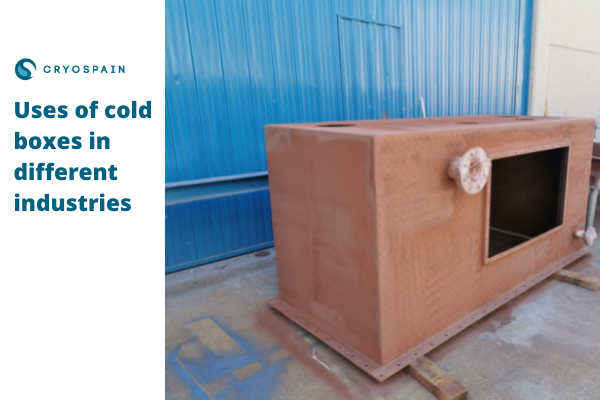The cold box has played a crucial role in the development of increasingly efficient cryogenic equipment, facilitating access to cryogenic equipment for many industries as demand for low temperatures surges.
What exactly are cold boxes and why are they key components for certain companies? Keep reading to find out.
What is a cold box?
A cold box is a component of cryogenic tanks whose goal is to insulate vulnerable connections in order to guarantee there are no heat losses. As such, these metallic boxes play an important role in guaranteeing cryogenic equipment works properly and efficiently.
Cold boxes rely on the following design parameters: they’re made using a double-wall system presenting a space between inner and outer walls which is filled with thermal insulating materials, such as expanded perlite, rockwool or cellular glass. The system is then sealed and uses nitrogen to perform pressure and purge processes.
Regarding the choice of insulation materials, it’s guided by factors such as the needed operating temperatures and other user requirements, as well as the AGI Q118 insulation standard. As a consequence, the decision should be taken based on each project’s specific cryogenic engineering needs.
Devising self-supporting cold box systems was necessary as the cryogenic industry advanced. As big-scale cryogenic equipment was increasingly demanded, an appropriate insulating system needed to be designed and implemented.
The list of cryogenic equipment that benefits from using cold boxes comprises the following systems:
- Cryogenic distillation columns
- Core-in-drums
- Expansion turbines
- Brazed aluminum plate-fin heat exchangers
- Certain piping and valve systems
- Liquid helium and liquid nitrogen phase separators
- Cryogenic adsorbers
- Other instrumentation
While cryogenic equipment usually uses vacuum insulation systems (such as high-vacuum super-insulated pipes), the use of bigger cryogenic solutions presents a challenge for this type of insulation. Alternatively, cold boxes provide the right fix for such large-scale equipment.
These systems prevent heat losses from happening, as well as providing an efficient insulation against the influence of external elements such as water, snow, dust and contaminants.
Additionally, the right cold box system will present other benefits, such as minimizing the installation space needed and providing a quick and easy installation and access to piping.
The following are among the most common components for cold boxes:
- Roof and side panels. In charge of providing protection, they’re typically made of stainless steel and closed by welded carbon-steel sheets
- Breather valves
- Perlite, rockwool or other types of insulating filling
- Emergency vents
- Floor drain
- Frame tubing
- Nitrogen purge system
Download our Cold boxes case study and discover all the technical information about one of our projects
The history of cold boxes
The history of the cold box is directly associated with the development of increasingly efficient insulation systems for cryogenics.
The first milestone in such a timeline was marked by Sir James Dewar, who first invented the vacuum-insulated model for cryogenic storage. In search of a system that could achieve the right thermal insulation to advance in the study of cold-temperature substances, Dewar developed the double-wall vacuum system at the beginning of the 20th century, a model that’s still at the base of many cryogenic equipment decades later.
Progress was made in obtaining decisive insulation improvements when powder insulations were developed by Dewar himself: introducing diverse powders in the vacuum space (such as bismuth oxide, silica or alumina, among others), he improved insulation properties up to 6 times.
Other important insulation developments were achieved when multilayer systems were devised in the 1950s. These represented yet another improvement to Dewar’s system and facilitated lightweight insulation for space rockets and their cryogenic propellants.
The arrival of cold boxes represented an appropriate solution to generate insulation for bigger cryogenic structures. These have allowed for the scale of operations to increase significantly, granting efficient insulation systems for large-volume structures and facilitating the emergence of sectors such as the growing LNG industry and the required LNG tankers.
Industrial uses of cold boxes
As stated above, the cold box has allowed the development of efficient insulation systems for large-scale cryogenic equipment.
This, in turn, has facilitated access to cryogenic substances for certain industries, who use technical gases for industrial production (such as oxygen, nitrogen and argon) but need to optimize their storage and transportation spaces by achieving cryogenic temperatures.
Cold boxes have played an especially relevant role in the development of efficient storage and transport structures for the natural gas industry and petrochemical processing plants, as well as some industrial gas applications.
By facilitating cold-chain logistics, cold box insulation systems have made it possible to transport temperature-sensitive cryogenics, turning it into an efficient process.
At the same time, the ability of the cold box to provide an insulated environment has played an important role in certain processes such as Natural Gas Liquefaction, methane and ethylene production, as well as ethylene recovery units, among other solutions.
All in all, cold boxes can represent an efficient solution for cryogenic storage and transportation systems. In order to guarantee each company fulfills their specific needs, it’s crucial that the right solutions are implemented, using the engineering knowledge and expertise of skilled industry players.
At Cryospain, we provide high-technology cryogenic engineering to match our clients’ needs, from storage to plants, stations and piping solutions, we’re able to generate tailor-made equipment for each project. Take a look at our cryogenic catalog and talk to our team of experts to find the right cryogenic solution to your needs.











 Contacte-nos
Contacte-nos